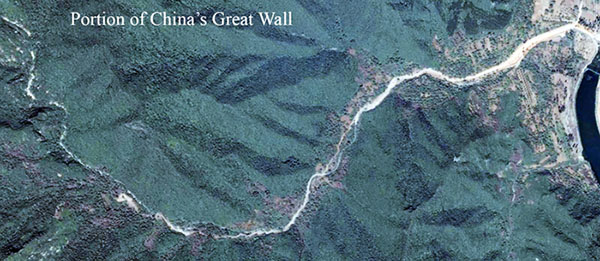The Great Wall of China
Today, a 2300-year-old wall. The University of Houston's College of Engineering presents this series about the machines that make our civilization run, and the people whose ingenuity created them.
Sooner or later, any series such as this must reach the Great Wall of China -- that cryptic, brooding snake, girdling a tenth of Earth's circumference. The Great Wall is, in fact, an array of shifting forms that spans millennia as well as miles.
Walls are woven into Chinese culture. The shabbiest village and the grandest city alike will boast a wall. The first Great Wall was a three-thousand-mile structure built of tamped earth. It was begun under the whip of the tyrannical emperor Qin, starting in 221 BC. Qin's people built upon earlier pieces of the wall, some of which had been in place for 150 years -- maybe longer.
The obvious purpose was to wall out northern barbarians. But the repressive paranoia of the regime suggests that Qin brought a great deal of pure self-aggrandizement to the project. Qin also built the underground terra cotta army of Xi-an. And his wall was thirty times the length of Hadrian's Wall -- built to keep northern invaders out of England.
After Qin's death in 208 BC, his evil empire collapsed. The far more humane Han dynasty soon replaced it. The Hans lasted over four centuries and left a huge technological legacy. They gave us paper. Within two generations they'd beaten back the northern invaders. Then they extended the Wall still farther west, all the way across the Gobi Desert. Of course, that merely established its location. The Wall didn't yet have its present appearance.
Down through the first millennium AD, various dynasties built more pieces. The Wall now extends from the Yellow Sea, across Northern China, below Mongolia, and along a big stretch of the Old Silk Road. It ends in what the Chinese called The Last Gate of the World -- in Central Asia, on China's far west border.
But the Wall we recognize came much later. It was largely the work of the fourteenth-century Ming dynasty. They were the civil engineers who built the Wall to over thirty feet high. They filled it with earth and faced it with brick or stone. They built it wide enough to accommodate a marching troop of soldiers. Theirs was the Wall with watchtowers every hundred yards. By the time the Ming dynasty was done, over 6300 miles of Wall (with its many loops and digressions) sprawled across northern China.
So what was the legacy of this vast effort? It probably did serve the purpose of keeping invaders out. But it was finished just as the new cannons were being perfected. Artillery was about to put an end to all great walls. A century ago, Robert Frost looked at traditional New England wall-building, and he mused upon its purposes. He said,
Oh, just another kind of out-door game;
...
Before I built a wall I'd ask to know
What I was walling in or walling out,
And to whom I was like to give offence.
Something there is that doesn't love a wall ...
I'm John Lienhard, at the University of Houston, where we're interested in the way inventive minds work.
(Theme music)
Needham, J., The Shorter Science & Civilisation in China: Vol. 5 (abridged: Colin A. Ronan) Cambridge: Cambridge Univ. Press, Chapter 2, 1995.
See also the Wikipedia article on the Great Wall.
Click here for the full text of Robert Frost's Mending Wall poem.

Satellite image of a portion of the Great Wall, courtesy of Google Earth